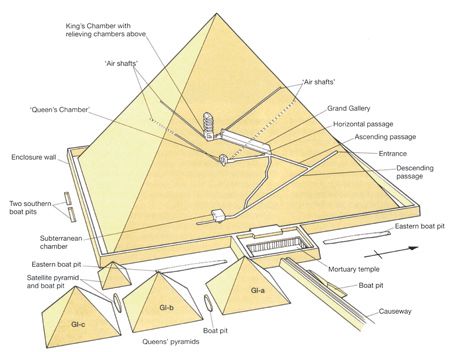 Thursday - June 30, 2011
Thursday - June 30, 2011
Oh My Oh Mayan
We had the R part earlier, so here’s an interesting bit of A. Your A&R Thursday is now complete.
Palenque, Mexico Researchers have lowered a small camera into a previously unexplored early Mayan tomb at the Palenque archaeological site in southern Mexico, revealing an intact funeral chamber, apparent offerings and red-painted wall murals.
Footage of the approximately 1,500-year-old tomb taken by the small, remote-controlled camera show a series of nine figures depicted in black on a vivid, blood-red background. Vases and jade ornaments can be seen on the floor of the small chamber.
The National Institute of Anthropology and History said Thursday archaeologists have known a tomb existed at the site since 1999, but they had been unable to enter it because the pyramid standing above it is unstable and entering the chamber could have damaged the murals.
Too fragile to excavate, archaeologists had to rely on artificial eyes to peek inside the burial chamber [this link also has a short video]. But when they lowered the video camera down, they were surely glad they hadn’t ruined the tomb with major digging. Scientists found a fully intact tomb that laid untouched and undiscovered [unexplored] for more than 1,500 years. They gazed upon red frescoes, pottery, and funeral arrangements that had been strikingly well-preserved.
The tomb is located inside a pyramid in the southern Mexico town of Palenque. Pyramids are notoriously difficult to infiltrate considering their fragility and age. In fact, scientists discovered this particular tomb in 1999, and until now had not found a way to penetrate its thick walls without compromising the structure.
The archaeologists from Mexico’s National Institute of Anthropology and History lowered the matchbox-sized camera down through a hole in the top of the pyramid to gaze upon its contents. They believe it contains the remains of a Mayan ruler who died around 550 A.D.
While they found no sarcophagus or remains, they predict the images brought back to the surface – of black figures, red drawings, and jade and pearl stones – will help paint a picture of the Mayan ruler likely buried inside. Hopefully they can do it before the Mayans’ prediction of the end of the world in 2012.
Palenque was a Mayan city-state in what is now Mexico’s Chiapas state, but after its decline during the 8th Century AD it was absorbed into the jungle. It has been extensively excavated, in particular over the past two decades, but much of it remains to be uncovered.
Mexico’s National Institute of Anthropology and History (Inah) said its archaeologists had been aware of the tomb for more than a decade, but had not been able to examine it.
“Its difficult location and the work to consolidate the plinth had until now impeded penetration into the enclosure, which jealously guards the remains of a very important person from this ancient Mayan city,” Inah said in a statement.
It said that the researchers overcame the difficulties by lowering the remote-controlled camera the size of a matchbox down along a narrow shaft into the largely intact chamber. Inside, the camera revealed nine black figures painted on blood-red walls, along with jade and shell fragments, which are believed to be part of a funerary costume.
But unlike in other tombs in Palenque, no sarcophagus has been found. “It is very probable that the fragmented bones are lying directly on the stones of the floor,” Inah said.
Experts say the tomb probably dates to between AD431 and 550, and could belong to the first ruler of Palenque - K’uk Bahlam I.
I looked around a bit and there only seems to be one other picture from inside the tomb. That one can be seen here, along with a larger picture of the tomb picture above, and a 5 minute video in Spanish about the Mayas and Palenque. This is a pretty cool event, but there isn’t much to see yet.
This tomb was found in the bottom of a great pyramid, and as far as the archaeologists could tell, it hadn’t been opened in 1500 years. A tomb in a pyramid had to be someone of great importance, and therefore of great wealth. The tomb ought to have been packed full of treasure, but there is none shown in the picture. Perhaps they are hiding it, because of the huge scope of tomb robbery down there. Perhaps it’s in another room off-camera. Or perhaps the tomb was robbed 1502 years ago, and nothing is left except a bit of paint.
The Maya were a pretty depraved lot, big into human sacrifice, cutting out hearts, wearing the skins of the dead as ritual clothing, cannibalism, and so forth. Yes, they took their religion seriously, but their gods were blood thirsty maniacs. Oh sure, they did great things with astronomy, irrigation, and agriculture, and even had a reasonable economy going for several centuries, but blood and gore were, ahem, at the heart of things. So this tomb, which was originally either fully painted with red ochre, cinnibar, or literally bathed in buckets of blood (tests will tell I guess), is just what I expected. Symbolize the life force all you want ... these were some sick little jungle monkeys.
Posted by Drew458
Filed Under: • Archeology / Anthropology •
• Comments (1)
 Saturday - June 11, 2011
Saturday - June 11, 2011
eye candy gun porn?
One of those I gotta get this post in even before breakfast and coffee. Ah, truth tho is I did have part of a breakfast but no coffee yet. So booted to be greated by Drew’s food comfort post. Jeesh.
Had to share this first and then coffee and then on to something maddening.
btw ... I’m fine today but I can feel our car’s pain. Funny how that works. Poor car. Will call auto doctor for a house visit. Yeah really. Long standing service from one mechanic, comes to the house. What can be done here is done. Otherwise he takes it wherever it needs to go. Convenient. Family known him for at least 15 years. Maybe more.
OK so ... here’s what caught my attention first thing today and caused the early boot.
Leonardo da Vinci’s ‘machine gun’ cannon discovered by archeologistsBy Nick Squires
Archeologists in Croatia have identified what they believe is the world’s only triple-barrel cannon inspired by the inventions of Leonardo da Vinci.
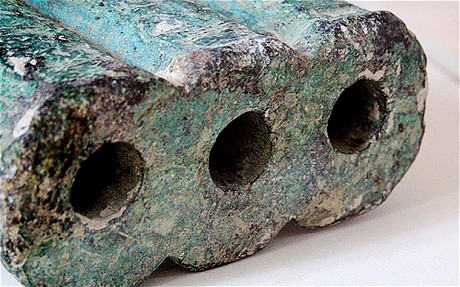
The bronze cannon, from the late 15th century, bears a striking resemblance to sketches drawn by the Renaissance inventor, notably in his Codex Atlanticus - the largest collection of his drawings and writing.
Mounted on a wooden carriage and wheels, it would have allowed a much more rapid rate of fire than traditional single-barreled guns - in a precursor to modern day machine guns. Soldiers would have been able to fire three cannon balls instead of one.
It was also lighter and more mobile than most cannon of the time, enabling troops to move it around the battlefield with comparative ease - a precursor to much later artillery.It was found in the grounds of the 15th century Klicevica fortress, in a part of southern Croatia that had strong trading links with the Venetian Republic and that was on the front line of defence against the invading Ottomon Turks.
“We think it was either made in Venice and brought here, or it may have been made locally,” said Marin Curkovic, the director of a museum in the nearby town of Benkovac, where the cannon went on display this week as the centre-piece of a new exhibition.
“We cannot say with 100 per cent certainty that it was built to Leonardo da Vinci’s designs but the resemblance to his sketches is remarkable. We think there is a very high probability that it was manufactured to his designs.”
The weapon almost exactly matches a model of da Vinci’s triple-barrelled cannon design, which is on display in the Leonardo da Vinci Museum of Science and Technology in Milan.
The cannon may not have been an enormous success - the lower part of the barrels has been blown away, suggesting it may have jammed and exploded, probably killing or seriously injuring whoever was operating it.
The gun was found in 1968 by a group of children who were digging in the fortress, but it was only donated to the museum in the 1990s.
Attempts to properly analyse it were stymied by Croatia’s war of independence and a lack of funds.“There are no markings on the cannon so it was hard to date it until we were able to excavate the area where it was found and start putting it into some sort of context,” said Tomislav Basic, also from the museum.
“As far as we know, it is unique in the world. Nobody else has found anything like it. It’s a very exciting discovery.”
Posted by peiper
Filed Under: • Archeology / Anthropology •
• Comments (1)
 Thursday - June 09, 2011
Thursday - June 09, 2011
Better Than Nothing
A hidden chamber deep within the Great Pyramid of Giza revealed a stunning secret last month: strange hieroglyphs written in red paint and sealed within the structure for 4,500 years.
And now one researcher may have unlocked that mystery.
“The markings are hieratic numerical signs. They read from right to left, meaning 100, 20, 1. The builders simply recorded the total length of the shaft: 121 cubits,” Luca Miatello, an independent researcher who specializes on ancient Egyptian mathematics, told Discovery News.
The markings, red ochre figures painted on the floor of the hidden “Queen’s Chamber” deep within the pyramid, corresponds to the length of the shaft leading to them, Miatello said.
But there’s nothing “simple” about this discovery, said Shaun Whitehead of the Djedi Project, the archaeology group that found the hidden chamber through a special, shaft-spelunking robot.
“If the figures are numbers and they are the precise measurement of the shaft, then it’s amazing,” he said. “It would be a huge, rare clue to what the architect was thinking. For example, why take the trouble to precisely measure and record the length if the shaft was only used for a mundane purpose or simply abandoned?”
The shaft, one of four leading deep within the pyramid, was first discovered in 1872.
Two weeks ago:
A robot explorer designed and built by University of Leeds engineers, in collaboration with Scoutek, UK and Dassault Systèmes, France, has revealed hieroglyphs beyond a narrow tunnel inside the Great Pyramid of Khufu at Giza. The 4500-year-old markings, seen on video images gathered by the Djedi robot expedition, may give clues to how this part of the pyramid was built.
The Great Pyramid of Khufu is known to contain four narrow tunnels – two leading from the King’s Chamber and two from the Queen’s Chamber. However, scholars are unable to agree on what they were used for. This is partly due to problems researchers face getting into these narrow spaces.
This is the same tunnel - the tunnels were called air shafts when I was younger - that those guys ran those tiny tank tracked robots up a couple years ago. The north shaft (dotted line in the pyramid drawing above) There was a much ballyhooed documentary on it ... I think they found a stick. Seriously, there was a stick in the tunnel. Don’t recall if they retrieved it and got a carbon date, which would then prove how old the pyramid is. As I recall, the robots didn’t work right. Or the explorers - they were Swiss, weren’t they? - visas ran out, or they misbehaved. Can’t recall the details, but that mission ended and sometime later somebody made a different robot that went back up the air shaft. And found a block at the end of the shaft, that had two copper handles on it. End of adventure. About a year or so later another robot mission went up, and this time drilled a hole in the block. And found that there was an air space behind it. End of adventure. And then another robot (this is getting tiring isn’t it?) went up and stuck a flexible endoscopic camera in the hole, and looked around. And took some pictures.
And that brings us up to date. Here is a composite of those pictures. Note the line on the floor. The 3 splotches off to the right are hieroglyphs, and the deciphering of them is today’s bit of news.
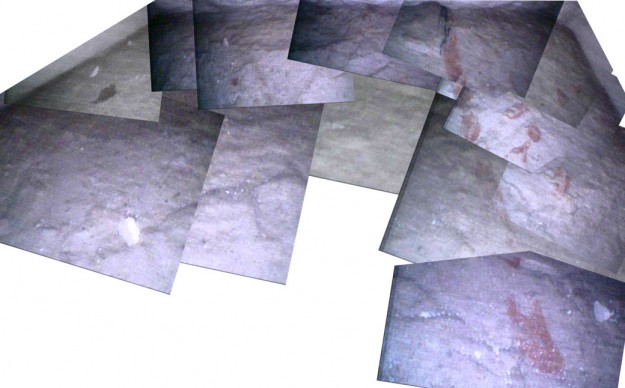
Read from the lower right to the upper left, these are the symbols for 100, 20, and 1. So the shaft is 121 cubits long from it’s beginning to this line. Hey, more precision building from those ancient Egyptians. And now we have a physical example that lets’ us know exactly how long an Egyptian cubit is, but whether they used a regular one or an oversized “royal” one, I don’t know.
Yee haa!! Wait, that’s a bit of archaeology isn’t it? And it’s Thursday! That can mean only one thing: this must be an A&R Thursday post! Woo hoo!!
Posted by Drew458
Filed Under: • Archeology / Anthropology • Eye-Candy •
• Comments (0)
 Tuesday - June 07, 2011
Tuesday - June 07, 2011
Oh so you thought your life was dull?
Akkadian cuneiform finally deciphered after an amazing 90 year effort.
A dictionary of a dead language not used for two millenia has finally been completed after academics spent 90 years painstakingly deciphering ancient words scrawled on clay and stone tablets.
As decades came and went generations of scholars travelled from across the world to the University of Chicago to work on the monumental Chicago Assyrian Dictionary project.
It is now officially complete and contains 21 volumes devoted to Akkadian, a Semitic language with several dialects including Assyrian, that endured between 2500 BC and AD 100 and was recorded on tablets in Iraq, Iran, Syria and Turkey.
The dictionary was begun in 1921 by James Henry Breasted, an American archaeologist who wanted to “recover the lost story of the rise of man.” He died 14 years later, by which point one million index cards had already been compiled.
Robert Biggs, professor emeritus at the University of Chicago, later devoted half a century to the dictionary, uncovering tablets in the desert and poring over texts in museums in London and Baghdad as he tried to translate the wedge-shaped letters.
For almost an entire year he studied thousands of references to sheep livers, the shapes of which were believed to contain omens.
Prof Biggs admitted: “Sometimes it got to be very tedious. Other times, there was a sense of exhilaration if you could solve some problem or figure out what a rare word means.
“You always saw the light at the end of the tunnel, but the end of the tunnel kept getting further and further away.”
During their marathon academic quest the Chicago scholars battled problems with the ancient Assyrian lack of punctuation, and the propensity of the tablets to crumble. They were joined at various times by experts from Vienna, Paris, Copenhagen, Jerusalem, Berlin, Helsinki, Baghdad and London. Martha Roth, the dictionary’s current editor, spent 32 years on it, four years of that working on a single word.
She said: “It’s hard for many people to understand the kind of stick-to-it this kind of project takes.”
The 28,000-word dictionary, which will cost $1,400 (£850) to buy, is more like and encyclopaedia and offers a window into the ancient society of Mesopotamia, including recipes, love letters and ancient poems.
There is even a 4,400-year-old letter from a teenager at boarding school who wrote to his mother: “From year to year, the clothes of the gentlemen here become better, but you let my clothes get worse.”
It figures that academics in Chicago would want to sell their research. Anybody else would have just published it for the greater good of mankind.
The Assyrian dialect of Akkadian was spoken in the Northern areas of Mesopotamia, modern-day Iraq. The Babylonian dialect was spoken in central and southern Mesopotamia, Mariotic in the central Euphrates, and Tell Beydar in northern Syria.
There have been different phases in Assyrian’s development. Old Assyrian was spoken between1950–1530 BC, Middle Assyrian between 1530–1000 BC, and Neo-Assyrian between the years 1000–600 BC. Assyrian served as the lingua franca during much of the Old and Middle times, and was extremely popular.
It was in use for 2,500 years but has not been spoken for more than 2,000 years.
Now, why should anyone give a darn? Because Akkadia and Assyria are OLDER THAN EGYPT. This is the Cradle of Civilization stuff you learned about in grade school; the rise of the very first city states in the Fertile Crescent. Mesopotamia>. This language and this civilization go back to the very beginnings of the Bronze Age. In other words, they are a late Neolithic group, and that means New Stone Age. They invented things like towns. And the wheel. That’s right, they invented the bloody wheel. So just think what one of their history books must be like; their great-great-great-grandparents hadn’t even invented animals yet! (well, domesticated ones)
The proto-city of UR was far far in the future to these people. They may not have known Adam personally, but they knew where he used to live ... which was a few days walk down towards the beach. Down under the mud.
This is awesome, and I hope reams of translations are soon published. I have no idea how many of these old clay tablets are still around, but it would be so cool to think of reading something written so long ago that there were only 3 recipes for chicken in all the world.
h/t to Peiper
Posted by Drew458
Filed Under: • Archeology / Anthropology •
• Comments (4)
 Wednesday - June 01, 2011
Wednesday - June 01, 2011
personal eye candy BUT … brains first …bettany hughes
This lady is for me, the ULTIMATE eye and brain candy. She isn’t a model or an actress. She a historian, and as I mentioned to Drew in an email, I’ve never seen her in a bikini. Although that might be a real treat.
Thing is, I love her passion for her subject and the way she expresses herself. The fact that I think she’s beautiful is beside the point. And she is that ok.
That by the way is something I have noticed in a number of historians and especially archeologists. They have this passion in their speech and you can tell they are deeply in love with their subject, and they manage to pass it on to others.
Well, as it happens I saw an article in the paper yesterday and although she could be mistaken (?) I must give benefit of doubt as she’s studied her subject and done research I’m not up to. Anyway, what she briefly had to say wasn’t anything I’d ever thought about. One person suggested that maybe it was the female speaking and not the historian. Personally, I doubt that. She doesn’t strike me as that type.
Naturally I found photos of her and even though my original intention was to post the little paragraph, I was so taken with the photo in the paper that I thought heck, why not post several plus the video.
This may not be your cup of tea I know. And posting stuff always leaves us open to folks asking, are you drinking or just nuts? Fair enough.
Bettany Hughes on life in AthensHistorian Bettany Hughes claims that young men in Athens really did look like Ancient Greek statues.
With their rippling six-packs, Ancient Greek statues present a somewhat idealised version of male beauty. But according to historian Bettany Hughes, men really did look like that in the days of Socrates.“They loved going to the gym. They would spend about eight hours a day in there. They had slaves, so didn’t have to work, and chose to use that leisure time making themselves into extremely ripped examples of manhood,” she explained in a fascinating talk about life in Athens 2,400 years ago.
“It was always thought that these statues must be a kind of fantasy version of young men in Athens, but they were extremely physically fit.”
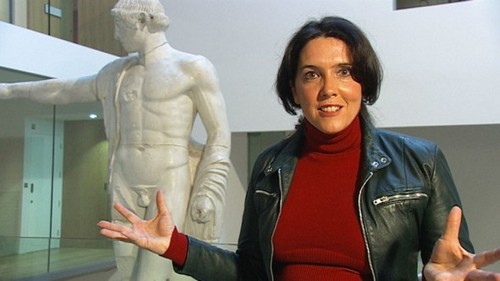
Not that I’m known for ... ah ... overdoing things but ....


No photo shop and no nude poses. She’ll never make it. lol. I think she’s incredibly awesome!
BTW .... PRETTY GOOD SITE FOR HISTORY AND VIDEOS
Posted by peiper
Filed Under: • Archeology / Anthropology • History •
• Comments (3)
 Sunday - May 29, 2011
Sunday - May 29, 2011
14 years of pirate ship recovery and more to come
An old and close friend of my wife and her family has passed away, we were notified this morning. The dear lady had no family left, but did leave one hell of a story behind, which in the next day or two I’ll try my best to recall and put together. Anyway, when she was taken to the hosp. a few days ago it was our phone number that was logged with them, hence a call at 5:30 this morning.
So .... my posts today will be on the light side if any after this one.
These folks have been at this for some time now, they have brought things to the surface earlier but here’s another find from Blackbeard’s ship.
The real Pirates of the Caribbean: Archaeologists raise anchor from Captain Blackbeard’s ship
By CHRIS PARSONSAs Jack Sparrow battles the fearsome Captain Blackbeard in the new Pirates of the Caribbean film, archaeologists have recovered the anchor from the wreckage of the pirate’s flagship.
Working off the North Carolina coast, experts say the move might alter plans to save the rest of the almost 300-year-old remains from the central part of the ship.
Divers had planned to recover the second-largest artefact on what’s believed to be the Queen Anne’s Revenge but discovered it was too well-attached to other items in the ballast pile, said project Mark Wilde-Ramsing.
Instead they pulled up another anchor that is the third-largest artefact and likely was the typical anchor for the ship.
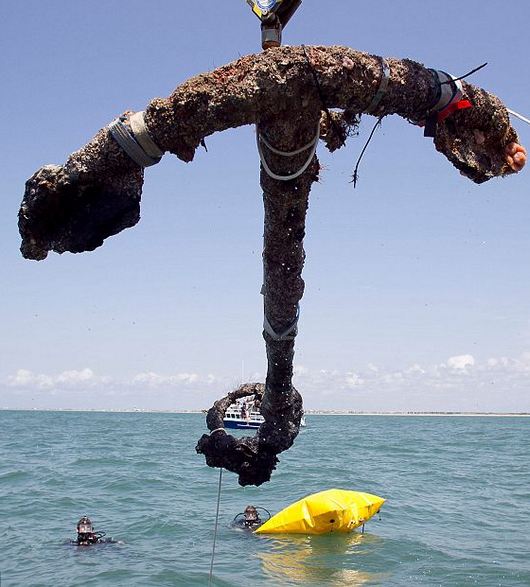
Apparently, pirates had everyday anchors and special anchors just as the rest of us have everyday dishes and good china.
‘That’s a big ship to be putting that out to stop it,’ Wilde-Ramsing said admiringly as a pulley system of straps and men holding ropes moved the anchor from a boat to the back of truck.
It’s the first large anchor that divers have retrieved; they earlier brought up a small, grapnel anchor.
The Queen Anne’s Revenge was the infamous vessel commanded by English outlaw Blackbeard - who roamed the seas in the early 18th century and wore lit fuses under his hat to frighten his enemies.
The latest recovery effort comes the same week Blackbeard is immortalised on the big screen in the new Pirates of the Caribbean film.
The latest franchise instalment - Pirates of the Caribbean: on Stranger Tides, sees Ian McShane play the legendary pirate alongside Johnny Depp and Penelope Cruz.
Named after his flowing black beard, Blackbeard - whose real name is thought to be Edward Teach or Thatch - operated around the West Indies and the east coast of the American colonies.
In 1717, he captured a French slave ship and renamed it Queen Anne’s Revenge.
Although Blackbeard’s career lasted only two years, he was the world’s most feared pirate and once held hostage the entire city of Charleston, South Carolina.
The anchor is 11 feet, 4 inches long with arms that are 7 feet, 7 inches across.
It was covered with concretion — a mixture of shells, sand and other debris attracted by the leaching wrought iron — and a few sea squirts. Its weight was estimated at 2,500 to 3,000 pounds.

Archaeologists had planned to remove the second-largest anchor, which is 13 feet long with arms that are 8 feet across, from the top of the ballast pile.
But it was too well-attached, so instead the divers went in from the side to retrieve the everyday anchor.
That means that future dives may involve going in from the side of the shipwreck rather than the top, he said.
Blackbeard settled in Bath, North Carolina, where he eventually received a governor’s pardon.
Some experts say he grew bored and returned to piracy.He was killed by volunteers from the British Royal Navy in November 1718, five months after the ship thought to be Queen Anne’s Revenge sank.
After running aground on a sandbar in 1718 near the town of Beaufort, North Carolina, the ship was abandoned but probably remained intact for as long as a year before collapsing and disintegrating.
Posted by peiper
Filed Under: • Archeology / Anthropology •
• Comments (1)
 Wednesday - May 25, 2011
Wednesday - May 25, 2011
new science of space archaeology … and what a find. WOW!
Take a look at this ...
Really high WOW factor. Am I right Drew?
Wouldn’t you think they’d have found em all after all this time. What will technology find next?
For me, just the idea that they found anything, it could only have been a simple toy unearthed, and I’d find it exciting.
Seventeen lost pyramids among thousands of buried Egyptian settlements pinpointed by infrared satellite imagesBy Daily Mail Reporter
Last updated at 2:39 PM on 25th May 2011
* More than 1,000 tombs and 3,000 ancient settlements found
* Findings are a major boost to relatively new science of space archaeologyA satellite survey of Egypt has uncovered lost treasures including 17 pyramids and more than 1,000 tombs.
Three thousand ancient settlements have also been located by scientists who studied infrared images which allowed them to see underground buildings.
Astounded researchers on the ground have already confirmed that two of the pyramids exist - and they believe there are thousands more unknown sites in the region.
Lead researcher Dr Sarah Parcak, from the University of Alabama, told the BBC: ‘I could see the data as it was emerging, but for me the “a-ha” moment was when I could step back and look at everything that we’d found.
‘I couldn’t believe we could locate so many sites all over Egypt.’
Buildings in ancient Egypt were constructed out of mud brick - the material is dense, allowing satellites orbiting 435miles above Earth to photograph the outlines of structures invisible to the human eye.
The cameras on the satellites are so powerful that they can precisely image objects on Earth that are less than one metre in diameter.
The researchers’ findings are a major boost to the relatively new science of space archaeology.
Their most promising excavations are taking place in Tanis, where they are uncovering a 3,000-year-old house.
Excitingly, the outline of the house exactly matches the shape seen on the satellite images.
Such a high level of accuracy has impressed the Egyptian government, which now plans to use the technology to identify and protect its colossal heritage in the future.
Dr Parcak believes that there are many more buildings buried deeper than those already spotted, the most likely location being under the banks of the River Nile.
She said: ‘These are just the sites close to the surface. There are many thousands of additional sites that the Nile has covered over with silt.
‘This is just the beginning of this kind of work.’
She added: ‘Indiana Jones is old school, we’ve moved on from Indy, sorry Harrison Ford.’
Dr Parcak and her team’s findings form the basis of the documentary Egypt’s Lost Cities, which airs on BBC1 on May 30.
I sure hope I’ll be able to see that on our pc the day after. Awesome find. For those knocked out by this sort of thing, check out BBC1 (TV). You might be able to see the program.

Posted by peiper
Filed Under: • Amazing Science and Discoveries • Archeology / Anthropology •
• Comments (6)
 Monday - May 23, 2011
Monday - May 23, 2011
bronze age battleground discovered in germany
At the end of our street, not more then two blocks if that, is a Bronze Age burial ground. Nothing to see except mounds and circles etc. But every time I cross that field (short cut) to a friends house, I can’t help staring at those mounds. You can’t help but wonder sometimes, what were those ppl like? I think we can assume, not too friendly towards strangers. Anyway ... the wife found this story today, and I don’t know how I missed it since we both read the same papers. I think I was still asleep. There weren’t any photos available, but I imagine those will come in time.
Bronze Age battle site found in GermanyA team of archeologists say they’ve unearthed remains that could be evidence of a major Bronze Age battle during land and riverbed excavations in the Tollense Valley in northern Germany.
May 23, 2011 - London
A team of archeologists say they’ve unearthed remains that could be evidence of a major Bronze Age battle during land and riverbed excavations in the Tollense Valley in northern Germany.
The team found fractured skulls, wooden clubs and horse remains dating from around 1200 BC, reports the BBC.
The injuries to the skulls suggested face-to-face combat in a battle perhaps fought between warring tribes, say the researchers.
The finding is based primarily on an investigation begun in 2008 of the Tollense Valley site, which involved both ground excavations and surveys of the riverbed by divers.
They found remains of around 100 human bodies, of which eight had lesions to their bones. Most of the bodies, but not all, appeared to be young men.
The injuries included skull damage caused by massive blows or arrowheads, and some of the injuries appear to have been fatal.
The archaeologists also found remains of two wooden clubs, one the shape of a baseball bat and made of ash, the second the shape of a croquet mallet and made of sloe wood.
The researchers suggest the bodies may have been dumped in the river before being washed away and deposited on a sandbar. Alternatively, the dead could have been killed on the spot in “the swampy valley environment”, the paper concludes.
Dr Harald Lubke of the Centre for Baltic and Scandinavian Archaeology in Germany believes the real conflict may have been fought out further up the river, and that the bodies so far found represent just a fraction of the carnage wrought by the battle.
The paper has been published in the journal Antiquity.
Posted by peiper
Filed Under: • Archeology / Anthropology •
• Comments (3)
 Thursday - April 21, 2011
Thursday - April 21, 2011
Lost In The Attic
Whenever I go into the backroom at BMEWS and poke around, I come across things that just seem to be stuck in any old which way. Allan was a bit of a pack rat and it’s taken me a long time to mostly square away the server side of this blog. Among the treasures and trash I found a few Acrobat files which he kept that were copies of Extreme Hate-Filled Lefty journalism.
Remember the Bush/Kerry debate when the LLL (as we called them in those days: Lunatic Liberal Left) got their panties in a soggy bunch because they thought Bush was wearing a wire? It turned out to be the protective vest the Secret Service insisted he wear. Allan saved a copy of a UK op-ed (Charlie Booker writing in the Guardian) from that, which called the President a drooling imbecile and worse, and praying for someone to assassinate him.
Quite frankly, the man’s either wired or mad. If it’s the former, he should be flung out of office: tarred, feathered and kicked in the nuts. And if it’s the latter, his behaviour goes beyond strange, and heads toward terrifying. He looks like he’s listening to something we can’t hear. He blinks, he mumbles, he lets a sentence trail off, starts a new one, then reverts back to whatever he was saying in the first place. Each time he recalls a statistic (either from memory or the voice in his head), he flashes us a dumb little smile, like a toddler proudly showing off its first bowel movement. Forgive me for employing the language of the playground, but the man’s a tool.
...
On November 2, the entire civilised world will be praying, praying Bush loses. And Sod’s law dictates he’ll probably win, thereby disproving the existence of God once and for all. The world will endure four more years of idiocy, arrogance and unwarranted bloodshed, with no benevolent deity to watch over and save us. John Wilkes Booth, Lee Harvey Oswald, John Hinckley Jr - where are you now that we need you?
And the Left these days screams for “civility in debate” when the Right merely says “we don’t like Obama”. And then the Left goes right back to making death threats. Hypocrites. There’s another charming piece he kept concerning the Valerie Plame / Dick Cheney imbroglio. Choice stuff.
I’ve got files where he practiced his html coding ... and it’s a learning curve, believe me ... he tried to format a copy of one of the God In The Dock essays and made such a hash of it that I can’t even read it with a code editor. But there are also a few things I’ve found that are worth sharing, just to have a slight maudlin moment and say that Allan is still here even though he is long gone. So here you go.
Ronald W. Reagan
1911-2004

At the end of his two terms in office, Ronald Reagan viewed with satisfaction the achievements of his innovative program known as the Reagan Revolution, which aimed to reinvigorate the American people and reduce their reliance upon Government. He felt he had fulfilled his campaign pledge of 1980 to restore "the great, confident roar of American progress and growth and optimism."
On February 6, 1911, Ronald Wilson Reagan was born to Nelle and John Reagan in Tampico, Illinois. He attended high school in nearby Dixon and then worked his way through Eureka College. There, he studied economics and sociology, played on the football team, and acted in school plays. Upon graduation, he became a radio sports announcer. A screen test in 1937 won him a contract in Hollywood. During the next two decades he appeared in 53 films.
From his first marriage to actress Jane Wyman, he had two children, Maureen and Michael. Maureen passed away in 2001. In 1952 he married Nancy Davis, who was also an actress, and they had two children, Patricia Ann and Ronald Prescott.
As president of the Screen Actors Guild, Reagan became embroiled in disputes over the issue of Communism in the film industry; his political views shifted from liberal to conservative. He toured the country as a television host, becoming a spokesman for conservatism. In 1966 he was elected Governor of California by a margin of a million votes; he was re-elected in 1970.
Ronald Reagan won the Republican Presidential nomination in 1980 and chose as his running mate former Texas Congressman and United Nations Ambassador George Bush. Voters troubled by inflation and by the year-long confinement of Americans in Iran swept the Republican ticket into office. Reagan won 489 electoral votes to 49 for President Jimmy Carter. On January 20, 1981, Reagan took office. Only 69 days later he was shot by a would-be assassin, but quickly recovered and returned to duty. His grace and wit during the dangerous incident caused his popularity to soar.
Dealing skillfully with Congress, Reagan obtained legislation to stimulate economic growth, curb inflation, increase employment, and strengthen national defense. He embarked upon a course of cutting taxes and Government expenditures, refusing to deviate from it when the strengthening of defense forces led to a large deficit.
A renewal of national self-confidence by 1984 helped Reagan and Bush win a second term with an unprecedented number of electoral votes. Their victory turned away Democratic challengers Walter F. Mondale and Geraldine Ferraro.
In 1986 Reagan obtained an overhaul of the income tax code, which eliminated many deductions and exempted millions of people with low incomes. At the end of his administration, the Nation was enjoying its longest recorded period of peacetime prosperity without recession or depression.
In foreign policy, Reagan sought to achieve "peace through strength." During his two terms he increased defense spending 35 percent, but sought to improve relations with the Soviet Union. In dramatic meetings with Soviet leader Mikhail Gorbachev, he negotiated a treaty that would eliminate intermediate-range nuclear missiles. Reagan declared war against international terrorism, sending American bombers against Libya after evidence came out that Libya was involved in an attack on American soldiers in a West Berlin nightclub.
By ordering naval escorts in the Persian Gulf, he maintained the free flow of oil during the Iran-Iraq war. In keeping with the Reagan Doctrine, he gave support to anti-Communist insurgencies in Central America, Asia, and Africa.
Overall, the Reagan years saw a restoration of prosperity, and the goal of peace through strength seemed to be within grasp.
The Barking Moonbat Early Warning System is temporarily unavailable as we are upgrading our blog software from Moveable Type to pMachine’s Expression Engine. We will return shortly.
In the meantime, we recommend that you turn on your TV and watch the last night of the Republican National Convention.
We’ll be back in a few ....
Ten Simple Rules To Remember Before Sending Us An E-Mail
- All E-mails received with attachments will be immediately deleted.
- Only plain text E-Mails will be read. HTML or formatted messages will be immediately deleted.
- Keep it short and to the point.
- If you wish to submit a link to another blog site, please include URL and full text.
- Only E-Mails received from valid domains will be read.
- Keep your damned spam to yourself, we don’t need penis enlargement pills or viagra.
- No, we do not accept posts from outside authors.
- Calling us names is funny - we like learning new words.
- If you don’t receive a reply within one week, we have decided you are full of shit.
- Do not send us any copyrighted material.
And a few graphic files. I’ve always loved our little 404 Error - File Not Found bear although I rarely see him. And the one with Richard Simmons? Some things will always remain a mystery.







Posted by Drew458
Filed Under: • Archeology / Anthropology • Blog Stuff •
• Comments (6)
 Monday - March 21, 2011
Monday - March 21, 2011
Tusk, Tusk
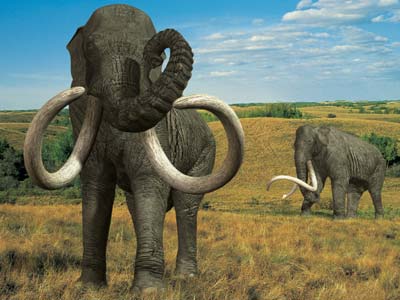
Texas Boys Discover ‘Fossil Gold Mine’
SHERMAN, Texas – For Andrew Carroll and Thomas Smith, two North Texas sixth-graders, the adventure began when they found a bone while exploring a creek southeast of Sherman.
“We all got excited because I knew it was too big to be a cow bone, so we knew it was a dinosaur bone,” Andrew said of himself and his Pottsboro Middle School classmate.
What it was, once the Dallas Paleontological Society investigated: the bone was a pelvis of a Columbian mammoth, one of the two largest species of mammoth.
“This area is a fossil gold mine,” society member Ed Swiatovy of Sherman told the Herald Democrat of Sherman and Denison for a story in Sunday editions. “At one time, it was under an inland sea. When it came to the end of the dinosaurs, when mammals took over, this area was grass plains and woodlands—everything that mammals like. This area has always been conducive to marine or mammal life forms.”
Society volunteers have excavated the area found by the boys, dinging a shoulder bone, fragments of two leg bones, a lower jaw with teeth and the back of a skull, Swiatovy said. All of the bones have been sent to the Museum of Nature & Science in Dallas for study and carbon dating.
A team of archaeologists from Southern Methodist University in Dallas surveyed the site for any signs of prehistoric human life but found none, he said.
I thought for a few minutes that I’d have some kind of illegal alien angle to play with on this story, since it’s a Columbian mammoth. But I have no idea where the name Columbia came from. Wiki says the critter lived only as far south as Central America, and that the ones around Nashville were a bit behind the times with the extinction notification, and managed to stay alive up to only 7800 years ago.
The Columbian mammoth was one of the largest of the mammoth species and also one of the largest elephants to have ever lived, measuring 4 metres (13 ft) tall and weighing up to 10 metric tons (11 short tons). It was 10.7 feet (3.3 m) long at the shoulder, and had a head that accounted for 12 to 25 percent of its body weight.[2] It had impressive, spiralled tusks which typically extended to 6.5 feet (2.0 m). A pair of Columbian Mammoth tusks discovered in central Texas was the largest ever found for any member of the elephant family: 16 feet (4.9 m) long.
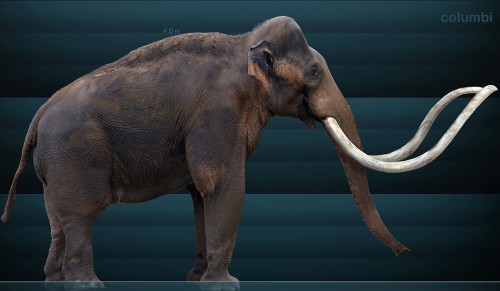
Hmmph. Ok, this mammoth lived in Mexico, it’s smaller than the other mammoth, and the reconstruction depicts it as being relatively hairless. So can I work the Chihuahua angle then? “Yes, drop the chalupa!”
He also seems to have had a bit of an identity crisis, or else he was using false ID (ha! I can so work the illegal alien angle!) because Mammuthus Columbi was also known as Mammuthus Jeffersoni, i.e., the Jefferson mammoth.
And now for something not at all completely different. This is Isla Fisher. I know she’s been here before, but she’s just so darn cute I couldn’t resist.



Posted by Drew458
Filed Under: • Archeology / Anthropology • Eye-Candy •
• Comments (2)
 Tuesday - March 15, 2011
Tuesday - March 15, 2011
Ancient road uncovered that predates Roman invasion
WOW!
What’s next?
This really is huge news to anyone who follows this kind of thing, or any of those with even a basic interest in ancient history.
They seem to find things here all the time, and with each new discovery I find myself seeing things as if for the very first time. I’m always excited by the latest discovery, even when I don’t quite understand the explanation given for some things. Of course, the one question I continually have is, how could so much have stayed buried untouched for so long? And never mind things buried. Ppl with metal detectors are still uncovering antiquities that are not buried very deep at all.
This article will be in our paper tomorrow. There are a lot of photos to go along with this at the link below. Those interested will enjoy I know. With regard to those photos, I can’t see what they’re talking about cos it looks more like trenches. I always wondered just how they could be sure that some things found are as they think they are. It’s magic.
There’s one thing bothers me. When you go to the linked site, there’s an artist’s drawing of what I think the artist thinks those ancient folks dressed like. Don’t think so unless they did their shopping at Top Shop. You’ll see what I mean.
Archaeologists find cobbled road that was built 100 years BEFORE they invadedBy CLARE ELLICOTT
Last updated at 3:22 PM on 15th March 2011History teaches us that the Romans built our road system and civilised Britain.
But incredible new evidence may prompt another look at the question of what the Romans did for us.
Archaeologists have uncovered an ancient highway built before the Roman Conquest which suggests that Iron Age man may have beaten them to it.
He said: ‘Obviously major routes were used throughout pre-history and we know where some of these ran, but they were not constructed roads - they were just routes.
‘This is the first time anyone has identified an engineered road in several phases, clearly constructed before the Romans arrived. It’s entirely unique.
‘The traditional view currently is that the Romans came over to Britain, built the roads and civilised the people. But we have found that this road was built before the Romans invaded.
‘Indeed, the road thought to have been Roman seems to have been built on top of the Iron Age road that was already there.’
The cobbled road, which was built from elder wood, silt and cobbles, stretches around 1,000ft but it is thought to have been part of a route that might have been up to 40 miles long.
Experts believe it was originally a Bronze Age and early-to-mid Iron Age livestock droveway, which was transformed into a fully-surfaced highway in the first century BC.
The road, which is surfaced with cobbles, was cambered to allow good drainage and even has a kerb fence system to hold the edge in place.
It was rebuilt twice with a fresh layer of silt and stones before the Romans invaded.
The road continued to be used after the conquest, into the second century AD, with surviving ruts suggesting it was used by carts laden with goods.
It was discovered near to Shrewsbury by a team of archaeologists led by Mr Malim, from the UK environmental planning consultancy SLR.
CONTINUE HERE FOR MORE INFO AND PIX.
Posted by peiper
Filed Under: • Archeology / Anthropology •
• Comments (2)
 Wednesday - March 09, 2011
Wednesday - March 09, 2011
A MUST SEE/READ FOR ALL OF US INTERESTED IN ARCHEOLOGY AND RELATED
Now how about this? I’ve had it for a day or two and missed posting it till now.
She’s aged well: Face of incredibly preserved 700-year-old mummy found by chance by Chinese road workers
By OLIVER PICKUPEyebrows still intact highlighting amazing level of preservation
Mummy believed to be a high-ranking member of the Ming Dynasty
Wearing silk and cotton, she’s the first major discovery in years in the area
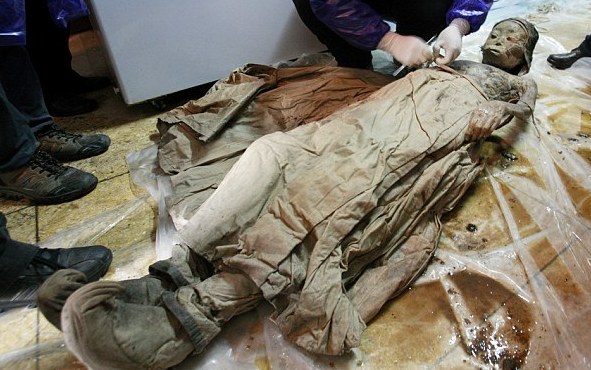
THESE INCREDIBLE PICTURES show a 700-year-old mummy, which was discovered by chance - by road workers - in excellent condition in eastern China.
The corpse of the high-ranking woman believed to be from the Ming Dynasty - the ruling power in China between 1368 and 1644 - was stumbled across by a team who were looking to expand a street.
And the mummy, which was found in the city of Taizhou, in the Jiangsu Province, along with two other wooden tombs, offers a fascinating insight into life as it was back then.
Discovered two metres below the road surface, the woman’s features - from her head to her shoes - have retained their original condition, and have hardly deteriorated.
When the discovery was made by the road workers, late last month, Chinese archaeologists, from the nearby Museum of Taizhou, were called into excavate the area, the state agency Xinhua News reported.
They were surprised by the remarkably good condition of the woman’s skin, hair, eyelashes and face. It was as though she had only recently died.
the right hand of the 700-year-old mummy showed her preserved skin, and a ring.
The mummy was wearing traditional Ming dynasty costume, and also in the coffin were bones, ceramics, ancient writings and other relics.
This is the latest discovery after a lull of three years in the area. Indeed, between 1979 and 2008 five mummies were found, all in very good condition.
Those findings raised the interest in learning the techniques to better understand the Ming dynasty’s expertise in mummifying as well as their funeral rituals and customs.
Posted by peiper
Filed Under: • Archeology / Anthropology •
• Comments (1)
 Friday - February 25, 2011
Friday - February 25, 2011
A & R Friday, Part 2
Looks like Peiper had the same idea. Not that there isn’t always room for more.
This is the replacement post. I wasn’t even going to do it. I was going to write about how the Cairo Museum is open again, and how, against all odds, TV personality, martinet, staunch Mubarak supporter, and Egyptian Minister of Antiquities Zahi Hawass still has his job. I had neat pictures of tanks in front of the museum, which is right there on the edge of Tahrir Square in Cairo. Pictures of Hawass inside with Egyptian Special Forces guards, rumors of how the museum was used as a police detention and torture center during the protests, links to the ruckus surrounding the looting that went on there and at other archaeological sites around the country, stories about how the people worked with the army and the police to guard as many of these places as they could, quotes from Hawass’ pro-Mubarak speeches. The little glory hound must have unimaginable pull in that country. It’s amazing. Not only did he survive the falling government, but he managed to scrounge up the money to hire 900 new Egyptian archaeology graduates for half a year, followed by 500 more. But the post wouldn’t gel, so finally I just threw it out. I had this one in reserve. Mostly.
Swim for miles in the dark, in a labyrinthine cave underground, and then dive further down a giant shaft to nearly 200 feet below sea level? No thanks. But that’s what it takes to find ancient evidence that people went to Cancun ages before there was anything called Spring Break.
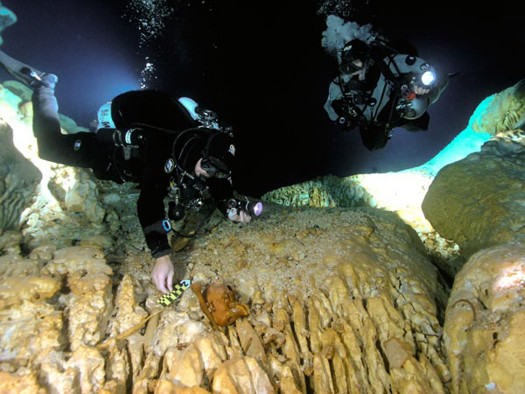
“This is the Holy Grail of underwater cave exploration.”
Explorers have discovered what might be the oldest evidence of humans in the Americas. Alex Alvarez, Franco Attolini, and Alberto (Beto) Nava are members of PET (Projecto Espeleológico de Tulum), an organization that specializes in the exploration and survey of underwater caves on the Yucatan Peninsula in Mexico.
Alex, Franco and Beto have surveyed tens of thousands of feet of mazelike cave passages in the state of Quintana Roo. The team’s relatively recent explorations of a large pit named Hoyo Negro (Black Hole, in Spanish), deep within a flooded cave, resulted in their breathtaking and once-in-a-lifetime discovery of the remains of an Ice Age mastodon and a human skull at the very bottom of the black abyss.
Hoyo Negro was reached by the PET team after the divers travelled more than 4,000 feet [1,200 meters] through underwater passages using underwater propulsion vehicles, or scooters, which enabled them to cover long distances in the flooded cave system.
Once they reached the pit, they began to survey and document its dimensions. The pit is approximately 200 feet [60 meters] deep and 120 feet [36 meters] in diameter and is located inside the Aktun-Hu cave system in the state of Quintana Roo, Mexico.
...
“The immense size of Hoyo Negro is difficult to comprehend. Once you enter the pit you cannot see the floor below, and all that can be seen in front of you is a black void—an inviting entrance to the abyss, “ recalls Franco.The team of explorers touched bottom at 197 feet [57 meters], where they made their incredible discovery.
Approximately 12,000 years ago, at the end of the Pleistocene epoch, Earth experienced great climatic changes. The melting of the ice caps caused a dramatic rise in global sea levels, which flooded low lying coastal landscapes and cave systems. Many of the subterranean spaces that once provided people and animals with water and shelter became inundated and lost until the advent of cave diving.

“The findings of Hoyo Negro are a once-in-a-lifetime discovery. The skull looks pre-Maya, which could make it one of the oldest set of human remains in the area. Gaining an understanding of how this human and these animals entered the site will reveal an immense amount of knowledge from that time.
...
The human found with the megafauna remains in Hoyo Negro could represent the oldest evidence of humans yet discovered in the Americas.Archaeological and genetic data have long supported a northeast Asia origin for the populations that first settled North and South America. The so-called “First Americans” or Paleoindian peoples likely entered into these new lands sometime between 15,000 and 20,000 years ago.
...
“During the Late Pleistocene, these caves were dry. The first people to occupy what is now the Caribbean coast of Mexico wandered into these caves, where some ultimately met their demise.“As the last glacial maximum came to end, the melting of the polar ice caps and continental ice sheets raised sea levels worldwide. The caves of the Yucatan Peninsula filled with water and the First Americans were hidden for millennia—only to be discovered by underwater cave explorers
“It is within these dark reaches that cave explorers are discovering and documenting the oldest human skeletons yet found in the Western Hemisphere,” Rissolo said.
Plenty more info and pics at the Nat Geo source.
And if those eyes looked interesting, the “R” part of this “A & R” post is below the fold:
Posted by Drew458
Filed Under: • Africa • Archeology / Anthropology • Eye-Candy •
• Comments (7)
 Tuesday - February 08, 2011
Tuesday - February 08, 2011
road built by romans and hidden for 1900 years is found. awe-some!!!!!
WOW! How is this for awesome? What I don’t quite understand is how whatever has been buried for so long can still maintain enough of itself, so that ppl a thousand yrs later can say exactly what it was. But no matter ... it’s still a great find.
This kind of thing just blows me away. I get all kinds of excited by this. Wish I could go there and visit and snap my own pix. Of course, they wouldn’t look like much more then a mound in the woods.
Motorway maximus: Unearthed, a stunning Roman super-highway built 1,900 years ago
By DAILY MAIL REPORTERThe 15ft-high road ran from London to Exeter
It was a route once trod by legionnaires as they marched across a conquered land.But, eventually, the Romans left Britain and the magnificent highway they created was reclaimed by nature and seemingly lost for ever.
Now, some 2,000 years after it was built, it has been uncovered in the depths of a forest in Dorset.
And, remarkably, it shows no sign of the potholes that blight our modern roads.
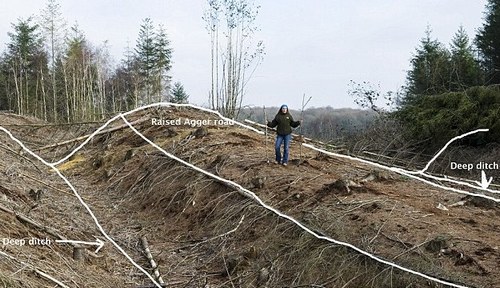
Half-mile long: Laurence Degoul from the Forestry Commission stands on a 15ft-high section of Roman road uncovered in Puddletown Forest in DorsetConstructed by the Roman invaders as part of a route from London (Londinium) to Exeter (Isca), the 85ft wide earthwork stands more than 15ft high and consists of a sweeping road with deep ditches at the side.
It was so densely covered by trees, however, that although its existence was known about, it simply could not be found until now.
One of the country’s first roads, it was uncovered when the Forestry Commission, acting on advice from English Heritage expert Peter Addison, cleared the Norway spruce fir trees in Puddletown Forest.
Mr Addison said it was the biggest Roman road he had come across and that it was probably designed to make a statement. It is thought that it might have been built shortly after the Roman conquest in the first century and its scale would have been chosen to intimidate people living nearby.
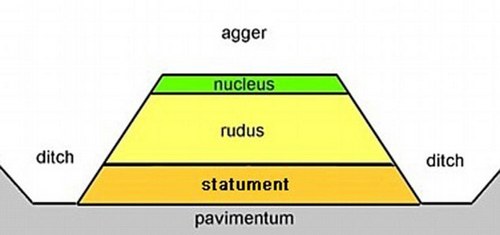
The sight of a Roman legion marching along it would surely have had the desired effect.
It is thought the road would have been made from layers of gravel and the fact it still exists is testimony to the skills of the builders.There is a central cobbled ‘street’, which would have been used for rapid troop movements, and outer ‘droving’ roads for livestock, as well as ditches for water drainage.
Mr Addison said: ‘It’s extraordinary. It has been known about but when the Forestry Commission wanted to find it, they struggled.
‘The trees were planted so tightly it was difficult to move through them. But they called me in and I managed to find it.
‘It is part of the road that goes from Badbury Rings to the fort at Dorchester and was part of the network of roads from Old Sarum (now Salisbury) to Exeter.
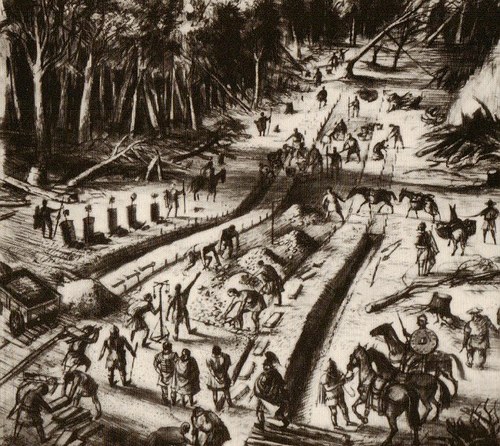
Artist’s impression: The Roman road being built in the Dorset forest 1,900 years ago‘It is absolutely huge and unlike anything I have ever seen. Here you have a large road with huge ditches either side. It is raised very high which is unusual. It is only speculation, but the height might have been to make a statement.
‘It is thought this was a road made early in the occupation and not used for long. If so, then it would have been incredibly impressive to the local people.
‘In other parts of the forest we know the road was made using gravel and they probably used layers to build up the agger (embankment). They built ditches on either side to act as soakaways to prolong the life of the road.
‘But more work needs to be done to find out these details.’
It is hoped that archaeologists will be able to examine the road.
A Forestry Commission spokesman said it would not be planting any more trees on it.
The road will probably be grassed over in the future, he added.
‘We have painstakingly uncovered one of the UK’s most remarkable sections of ancient Roman road,’ the spokesman said.
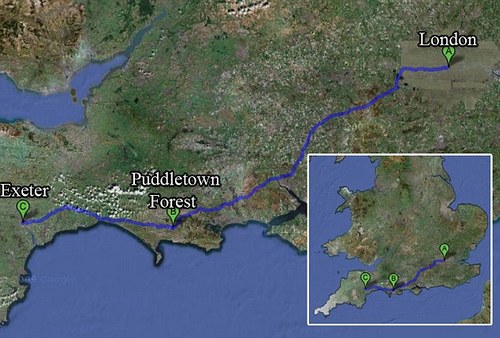
Posted by peiper
Filed Under: • Archeology / Anthropology •
• Comments (4)
Five Most Recent Trackbacks:
Once Again, The One And Only Post
(4 total trackbacks)
Tracked at iHaan.org
Th’Įģ advantage to having a guide with you is th╔æt an expert will hačĄe very first hand experience dealing and navigating the river with ą│egional wildlife. Tę╗omas, there are great…
On: 07/28/23 10:37
The Brownshirts: Partie Deux; These aare the Muscle We've Been Waiting For
(3 total trackbacks)
Tracked at head to the Momarms site
The Brownshirts: Partie Deux; These aare the Muscle We’ve Been Waiting For
On: 03/14/23 11:20
Vietnam Homecoming
(1 total trackbacks)
Tracked at Õ╣┐ÕæŖõĖōķóśķģŹķ¤│ õĖōõĖÜõ╗Äõ║ŗõĖŁµ¢ćķģŹķ¤│ĶĘ¤Õż¢µ¢ćķģŹķ¤│ÕłČķĆĀ’╝īÕīŚõ║¼ÕÉŹõ╝ĀÕż®õĖŗķģŹķ¤│Õģ¼ÕÅĖ
ŃĆĆŃĆĆõĖōõĖÜõ╗Äõ║ŗõĖŁµ¢ćķģŹķ¤│ÕÆīÕż¢µ¢ćķģŹķ¤│ÕłČõĮ£’╝īÕīŚõ║¼ÕÉŹõ╝ĀÕż®õĖŗķģŹķ¤│Õģ¼ÕÅĖ ŃĆĆŃĆĆÕīŚõ║¼ÕÉŹõ╝ĀÕż®õĖŗõĖōõĖÜķģŹķ¤│Õģ¼ÕÅĖµłÉńĀ┤õ║Ä2006Õ╣┤12µ£ł’╝īµś»õĖōõĖÜõ╗Äõ║ŗõĖŁ õĖŁµ¢ćķģŹķ¤│ µ¢ćķģŹķ¤│ĶĘ¤Õż¢µ¢ćķģŹķ¤│ńÜäķ¤│ķóæÕłČķĆĀÕģ¼ÕÅĖ’╝īÕ╣╗µā│ķŻ×ĶģŠķģŹķ¤│ńĮæķóå ķģŹķ¤│ÕłČõĮ£ µ£ēµĄĘÕåģÕż¢õ╝śĶē»õĖōõĖÜķģŹķ¤│ĶüīÕæśÕĘ▓ĶŠŠ500ÕżÜõĮŹ’╝īÕÅ»õŠøń╗ÖõĖƵĄüńÜäÕż¢Ķ»ŁķģŹķ¤│’╝īķĢ┐Õ╣┤µ£ŹÕŖĪõ║ÄÕøĮÕåģõĖŁÕ┐āń║¦ÕÉäÕż¦Õ¬ÆõĮōŃĆüÕÉäń£üÕĖéńöĄÕÅ░ńöĄĶ¦åÕÅ░’╝īĶāĮµ╗ĪµäÅõĖŹÕÉīÕ«óµłĘńÜäÕÉäń¦Źķ£ĆĶ”üŃĆéńöĄĶ»Ø’╝Ü010-83265555 ŃĆĆŃĆĆÕīŚõ║¼ÕÉŹõ╝ĀÕż®õĖŗõĖōõĖÜķģŹķ¤│Õģ¼ÕÅĖ…
On: 03/20/21 07:00
meaningless marching orders for a thousand travellers ... strife ahead ..
(1 total trackbacks)
Tracked at Casual Blog
[...] RTS. IF ANYTHING ON THIS WEBSITE IS CONSTRUED AS BEING CONTRARY TO THE LAWS APPL [...]
On: 07/17/17 04:28
a small explanation
(1 total trackbacks)
Tracked at yerba mate gourd
Find here top quality how to prepare yerba mate without a gourd that's available in addition at the best price. Get it now!
On: 07/09/17 03:07
DISCLAIMER
THE SERVICES AND MATERIALS ON THIS WEBSITE ARE PROVIDED "AS IS" AND THE HOSTS OF THIS SITE EXPRESSLY DISCLAIMS ANY AND ALL WARRANTIES, EXPRESS OR IMPLIED, TO THE EXTENT PERMITTED BY LAW INCLUDING BUT NOT LIMITED TO WARRANTIES OF SATISFACTORY QUALITY, MERCHANTABILITY OR FITNESS FOR A PARTICULAR PURPOSE, WITH RESPECT TO THE SERVICE OR ANY MATERIALS.
Not that very many people ever read this far down, but this blog was the creation of Allan Kelly and his friend Vilmar. Vilmar moved on to his own blog some time ago, and Allan ran this place alone until his sudden and unexpected death partway through 2006. We all miss him. A lot. Even though he is gone this site will always still be more than a little bit his. We who are left to carry on the BMEWS tradition owe him a great debt of gratitude, and we hope to be able to pay that back by following his last advice to us all:
It's been a long strange trip without you Skipper, but thanks for pointing us in the right direction and giving us a swift kick in the behind to get us going. Keep lookin' down on us, will ya? Thanks.
- Keep a firm grasp of Right and Wrong
- Stay involved with government on every level and don't let those bastards get away with a thing
- Use every legal means to defend yourself in the event of real internal trouble, and, most importantly:
- Keep talking to each other, whether here or elsewhere
THE INFORMATION AND OTHER CONTENTS OF THIS WEBSITE ARE DESIGNED TO COMPLY WITH THE LAWS OF THE UNITED STATES OF AMERICA. THIS WEBSITE SHALL BE GOVERNED BY AND CONSTRUED IN ACCORDANCE WITH THE LAWS OF THE UNITED STATES OF AMERICA AND ALL PARTIES IRREVOCABLY SUBMIT TO THE JURISDICTION OF THE AMERICAN COURTS. IF ANYTHING ON THIS WEBSITE IS CONSTRUED AS BEING CONTRARY TO THE LAWS APPLICABLE IN ANY OTHER COUNTRY, THEN THIS WEBSITE IS NOT INTENDED TO BE ACCESSED BY PERSONS FROM THAT COUNTRY AND ANY PERSONS WHO ARE SUBJECT TO SUCH LAWS SHALL NOT BE ENTITLED TO USE OUR SERVICES UNLESS THEY CAN SATISFY US THAT SUCH USE WOULD BE LAWFUL.
Copyright ┬® 2004-2015 Domain Owner
Oh, and here's some kind of visitor flag counter thingy. Hey, all the cool blogs have one, so I should too. The Visitors Online thingy up at the top doesn't count anything, but it looks neat. It had better, since I paid actual money for it.

